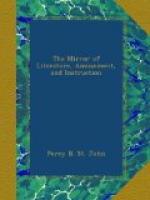[1] Britton, Arch. Dict.
art. Bridge. On the decline of the Roman
Empire,
travelling became dangerous, and robberies and murders
were
frequently committed. To check this system, and
protect
travellers,
several religious persons associated in fraternities,
and
formed an order called the “Brothers of the Bridge.”
Their
object
was to build bridges, establish ferries, and receive
and
protect
travellers in hospitals, raised near the passes over
rivers.
In like manner we account for the erection of many
bridges
in England. According to Stow, the monks of St.
Mary
Overie’s
were the first builders of London Bridge: and
Peter of
Colechurch,
who founded the first stone bridge, also built
a
chapel on the eastern central pier, in which the architect
was
afterwards
interred: his remains, as we first communicated
to the
public,
were found as aforesaid during the recent removal of
the
old
bridge; and “the lower jaw and three other bones
of Peter of
Colechurch”
were sold by auction a few days since.
[2] At the old bridge at Droitwich,
the high road passed through the
midst
of the chapel, the reading-desk and pulpit being on
one
side,
and the congregation on the other. Other public
buildings
were
not uncommon on bridges. In 1553 an alderman of
Stamford
built
the Town Hall upon the bridge there; and on an old
bridge
at
Bradford, Wills, there is a sort of dungeon, or prison
raised
on
one of the piers.
[3] Camden. Tindal’s Notes on Rapin.
* * * * *
THE BROTHER OF OLIVER GOLDSMITH.
(To the Editor.)
As I was personally acquainted with Charles Goldsmith, the younger brother of Oliver, the Poet, I am enabled to furnish a few particulars in addition to those of Philo, contained in No. 573 of The Mirror. Charles, on his coming to this country, from the West Indies, had with him two daughters, and one son named Henry; all under 14 years of age. He purchased two houses in the Polygon, Somers Town, in one of which he resided: here, the elder of his girls died; I attended her funeral; she was buried in the churchyard of St. Pancras, near the grave of Mary Wolstonecroft Godwin. Henry was my fellow pupil; but not liking the profession of engraving, after a short trial, he returned to the West Indies. At the peace of Amiens, Charles Goldsmith sold his houses, and, with his wife and daughter, and a son born in England, christened Oliver, he went to reside in France, where his daughter married. In consequence of the orders of Buonaparte for detaining British subjects, Charles again returned home by way of Holland, much reduced in circumstances, and died, about 25




